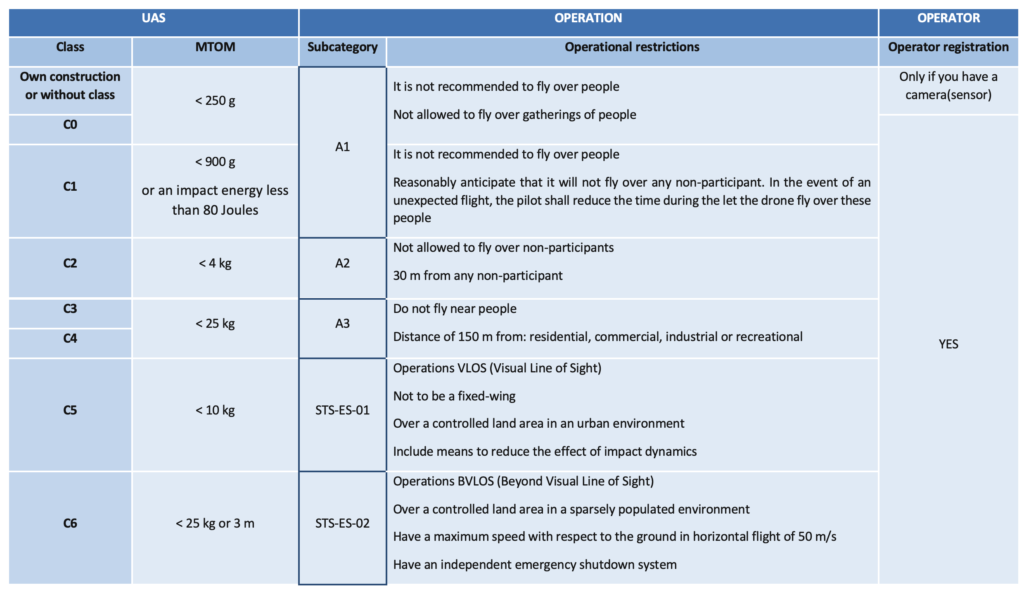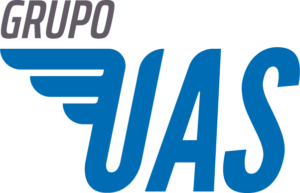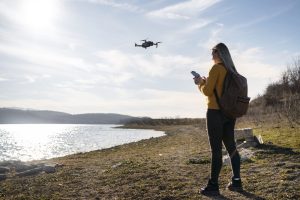Unmanned aerial vehicles are composed of a combination of electronic, mechanical and software components that allow them to fly and perform various tasks. This is why we can differentiate between several types of drones.
RPAS (Remotely Piloted Aircraft System) can be remotely controlled by a human pilot through a remote control or can be programmed to follow a predefined route using GPS navigation systems. Some drones can also operate autonomously using sensors and artificial intelligence algorithms to perform specific tasks.
They can have different sizes and configurations, from small handheld devices to large unmanned aircraft.
Below we will develop a classification of drones according to some of their characteristics:
Drones according to their structure
Fixed wing drones
Fixed-wing drones are those that have a certain similarity with the traditional structure of an airplane, they are composed of an elongated central body from which fixed wings emerge. These wings are the ones that provide the necessary lift to stay in the air. The particularity of this type of drone is that it takes advantage of aerodynamics to soar efficiently.
Among its main advantages are its energy efficiency, which allows it to enjoy a great autonomy. They also have great stability, being able to withstand high speed winds.
As disadvantages we can highlight that they are more expensive than multirotors. On the other hand, they are more difficult to fly.
Rotary wing drones
Currently, rotary wing drones can be helicopters or the most popular multirotor drones on the market. The price varies between drones depending on their characteristics. Their main difference is that they can hover over the same point, take off and land vertically. As an advantage, their great maneuverability stands out.
On the other hand, flight autonomy is reduced and it is weaker in adverse weather conditions.
VTOL drones (Vertical take-off and landing)
VTOL is the name given to the type of hybrid unmanned aircraft. It combines on the one hand the rotors of a multirotor, which it uses for take-off and landing, and on the other hand the fixed wing system, which provides another type of flight by generating lift and stability.
Drones by number of propellers
The most representative drones are the following:
Tricopter
This drone is one of the least used. It has three arms, of which the front ones rotate each in one direction, and the rear arm acts as a servomotor to provide stability to the unmanned aircraft.
Quadcopter
This is the most common type. This drone consists of four arms, with a motor on each arm. Two rotate clockwise and the other two counterclockwise. This feature allows an adequate thrust force to be created to lift the drone by counteracting the torque forces.
Hexacopter
Another of the unmanned aircraft most commonly used in professional work. It has six arms and six motors, as a consequence it provides great stability and safety.
Octocopter
This drone has eight arms, with a motor in each one of them. This feature gives it more power. As a consequence, its weight is greater and its maneuverability in reduced spaces is limited.
Coaxial
Unlike the drones mentioned above, the main characteristic of these drones is that they have two motors on each arm. For this reason they become more powerful drones, which allow to carry a greater weight, very convenient for the transport of goods.
Drones according to AESA regulations
Currently, the regulations establish seven CE class markings. The differences between them lie in the operational restrictions they have and their safety systems.
We can differentiate between those that can fly in open category (C0, C1, C2, C3, C4) and those that can fly in specific category in standard scenarios (C5 and C6), all drones that have a class marking must have the class label visible on their structure.

The following table shows the main characteristics of each of the class markings:

Class C0
Drones with this class marking have the lowest technical requirements. The most outstanding feature is that they must be powered by electricity, and designed to avoid harming people.
Class C1
Drones with this class marking have higher technical requirements. On the one hand, they must have a unique serial number. On the other hand, they must have a direct remote or network identification system. In addition, it must be equipped with a geo-awareness system. Other features are that it must be equipped with a low battery warning system for the UAS and the control station, a system for safe termination of flight (RTH) and equipped with controllability lights and visible at night.
Class C2
Unmanned aircraft with this class marking, apart from the requirements for class C1. They must have a data link protected against unauthorized access to command and control functions and a low speed function (3m/s) selectable by the pilot from the control station.
Class C3
Drones with this class marking, although they share some characteristics with C2 drones, differ mainly by the increase of the MTOM limit. These drones can only operate in A3 open category environments.
Class C4
The particularity of these drones is that they have been designed for the practice of aeromodelling. For this reason, the technical requirements are lower. This type of drone must be safely controllable. In addition, they cannot have automatic control modes, except for flight stabilization assistance.
Class C5
These drones, due to the standard scenario for which they are intended, are among those with the most technical requirements. In addition to all the requirements for drones with class C2 and C3 markings, several are added.
To be equipped with a selectable low speed mode limiting the speed to 5 m/s maximum. Have a method of data link recovery, command and control, or in case of failure, a safe flight termination system.
A Class C5 drone may be a Class C3 drone with an accessory kit installed that converts the aircraft into a Class C5 drone.
Class C6
Class C6 drones meet all the requirements of the previous one, in addition, they allow them to be fixed-wing structures, they are not limited to the use of only electric power, and can use combustion engines.
Uses
Depending on the use and purpose for which they are intended, we can distinguish two types of drones.
Recreational drones
Recreational use of drones focuses on entertainment and personal fun. In general, they tend to have fewer restrictions or are less demanding, however, drones must be used responsibly and comply with the security and privacy regulations established by law.
Their most widespread application is audiovisual, taking aerial shots to obtain videos and photographs for personal use.
It is important to remember that, even if it is a recreational use, it is necessary to take the drone pilot course and have the corresponding title in order not to incur in illegalities.
Drones for professional use
Drones are used professionally for specific purposes related to commercial, industrial or service activities.
Professional drone operators are involved in activities that may have legal, economic or safety implications. As such, they are subject to very strict regulation.
If professional drone work is to be carried out, it is highly recommended to have a drone consultancy to support the operations, in order to achieve successful and legally compliant projects.
Professional use covers a wide range of applications, such as industrial inspections, photogrammetry, and precision agriculture, among others.



